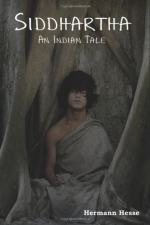|
This section contains 5,783 words (approx. 20 pages at 300 words per page) |

|
SOURCE: “Rebel-Seeker: Montagnola 1919–1931,” in Hermann Hesse: Life and Art, University of California Press, 1978, 159–72.
In the following excerpt, Mileck examines the influences that led Hesse to write Siddhartha, which he calls “a depiction of the human condition … and a sublime statement of faith in man and life.”
Siddhartha: Ideal Possibility
India and China
Klingsors letzter Sommer marked the end of the wildest and the most prolific summer of Hesse's life. His frenzy of activity subsided when autumn set in and, before winter, he had again become withdrawn, given to reflection and to plans for his next story. Part I and much of Part II of Siddhartha were written in the winter and spring of 1920. Dissatisfied with the chapter “At the River” (Am Flusse), Hesse put the novel aside in June 1920. He did not resume work on it until the end of 1921, and did not finish it until May 1922. The...
|
This section contains 5,783 words (approx. 20 pages at 300 words per page) |

|


